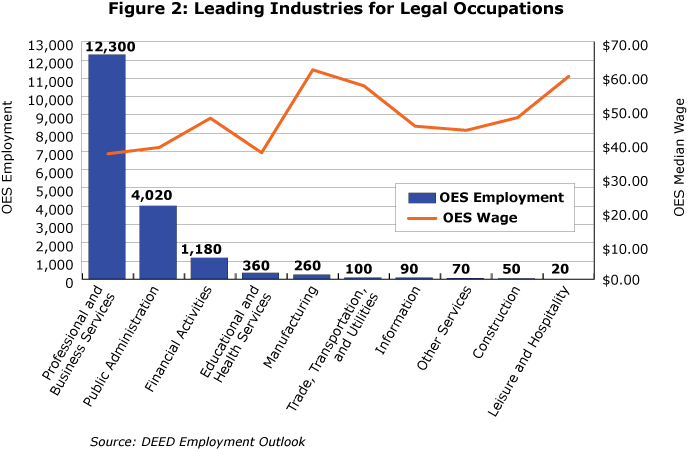by Bettsy Hjelseth
August 2016
DEED's Occupational Employment Statistics define lawyers as professionals who represent clients in criminal and civil litigation and other legal proceedings, draw up legal documents, or manage or advise clients on legal transactions. Lawyers may specialize in a single area or may practice broadly in many areas of law (see Figure 1).
| Figure 1: Common Tasks for Lawyers |
|---|
|
| Source: DEED Career and Education Explorer Tool |
According to DEED's Career Profile, the median wage for lawyers in Minnesota is $53.50 an hour or about $111,280 a year. The median hourly wage is $2.64 less than the national median wage which is $56.14. The job market in Minnesota for lawyers is expected to grow 0.7 percent in the next year which will create new 210 job openings. According to OES data the industry that employs the most lawyers in Minnesota is the Professional and Business Services industry. Approximately 7,430 lawyers are employed at a median wage rate of $53.31 per hour in this industry.
The educational requirement to become a lawyer is a professional or doctoral degree. After that, graduates must pass their state bar examination to receive a license to practice. In June 2013 there were 949 graduates in the state. The median hourly wage of these graduates was $23.09 one year after graduation and $28.07 two years after graduation.
Of the seven regions in Minnesota, during this period the Twin Cities employed about 84 percent of Law Degree graduates two years after graduation. The remaining 16 percent of graduates were employed throughout the rest of Minnesota. The Twin Cities region pays those with a law degree the highest median wage two years after graduation, $28.59, while the Northeast region pays those with a law degree the lowest median wage two years after graduation, $22.95 (see Table 1).
| Table 1. Employment Estimates, First Quarter 2016 | |||
|---|---|---|---|
| Geography | OES Estimated Employment | Median Wage | Projections Percent Change 2014 - 2024 |
| Minnesota | 10,690 | $53.50 | 5.50% |
| Seven County Metro | 8,860 | $57.28 | 5.00% |
| Central Minnesota | 510 | $33.35 | 6.30% |
| Southeast Minnesota | 400 | $36.56 | -2.70% |
| Northeast Minnesota | 310 | $37.17 | 0.80% |
| Southwest Minnesota | 260 | $39.18 | 4.10% |
| Northwest Minnesota | 200 | $37.02 | 5.50% |
| United States | 609,930 | $56.14 | NA |
| Source: DEED Occupational Employment Statistics | |||
According to DEED's Job Vacancy Survey, there were 124 lawyer job vacancies in the fourth quarter of 2015, compared to 88 job vacancies in the fourth quarter of 2014. In the fourth quarter of 2015 about 81 percent of the job openings required one or more years of experience, while 91 percent of the job openings required one or more years of experience in 2014. The median wage offered for those vacancies in 2015 was $28.54 an hour, while in 2014 it was $35.23.
Those working in legal occupations include lawyers, judges, paralegals, legal assistants, and related workers. As of the first quarter in 2016, there were 18,450 employees in Minnesota who worked in a legal occupation. The median wage for these employees was $38.40 an hour. The number of legal occupation jobs in Minnesota is projected to increase 4.6 percent by 2024.
The top two industries for employing legal professionals are the Professional and Business Services industry and the Public Administration industry. Specifically, about 67 percent or 12,300 of those working in a legal occupation are employed in the Professional and Technical Services industry, while 22 percent or 4,020 of are employed in the Public Administration industry. The median wage for those working in the Professional and Business Services industry is $36.99 an hour, while the median wage for those working in the Public Administration industry is $38.85 an hour. According to OES data, the median wages are highest for legal occupation employees who are working in the Manufacturing industry and lowest for those working in the Professional and Business Services industry (see Figure 2).

Although it takes extra years of schooling to become a lawyer, the future payoff might just be worth it for those who are passionate about the law. Although the Minnesota job market for lawyers is only expected to increase a modest amount within the next year, new jobs will be created.
For students just getting out of school, the wages start low. However, after a few years of experience, Minnesota lawyers make a decent amount of money which may make all the schooling and long hours of work worth the effort.